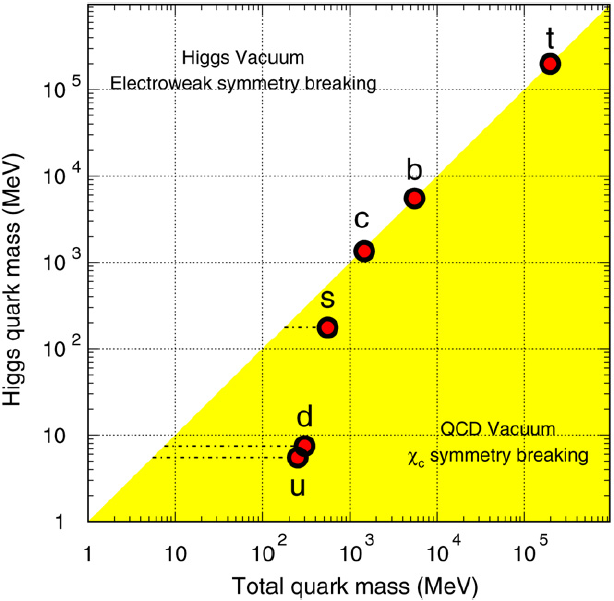Heavy Flavor
 Depending on the energy scale, there are two mechanisms that generate quark masses with different degrees of importance: current quark masses are generated by the electroweak symmetry breaking mechanism (Higgs mass) and spontaneous chiral symmetry breaking leads to the constituent quark masses in QCD (QCD mass). The QCD interaction strongly affects the light quarks (u, d, s) while the heavy quark masses (c, b, t) are mainly determined by the Higgs mechanism. In high-energy nuclear collisions at RHIC, heavy quarks are produced through gluon fusion and qq¯ annihilation. Heavy quark production is also sensitive to the parton distribution function. Unlike the light quarks, heavy quark masses are not modified by the surrounding QCD medium (or the excitations of the QCD medium) and the value of their masses is much higher than the initial excitation of the system. It is these differences between light and heavy quarks in a medium that make heavy quarks an ideal probe to study the properties of the hot and dense medium created in high-energy nuclear collisions.
Depending on the energy scale, there are two mechanisms that generate quark masses with different degrees of importance: current quark masses are generated by the electroweak symmetry breaking mechanism (Higgs mass) and spontaneous chiral symmetry breaking leads to the constituent quark masses in QCD (QCD mass). The QCD interaction strongly affects the light quarks (u, d, s) while the heavy quark masses (c, b, t) are mainly determined by the Higgs mechanism. In high-energy nuclear collisions at RHIC, heavy quarks are produced through gluon fusion and qq¯ annihilation. Heavy quark production is also sensitive to the parton distribution function. Unlike the light quarks, heavy quark masses are not modified by the surrounding QCD medium (or the excitations of the QCD medium) and the value of their masses is much higher than the initial excitation of the system. It is these differences between light and heavy quarks in a medium that make heavy quarks an ideal probe to study the properties of the hot and dense medium created in high-energy nuclear collisions.
Heavy flavor analyses at STAR can be separated into quarkonia, open heavy flavor and heavy flavor leptons.
Upsilon pp, dAu, AuAu GPC E-mail Responses
This is a page to house long e-mail responses.
Presentations
Page for uploading presentation drafts.
STAR Regional Meeting: Heavy Quark Production and Correlations 2012
Updated on Thu, 2012-11-01 08:52. Originally created by lkosarz on 2012-10-18 16:20.Faculty of Physics, Warsaw University of Technology, Warsaw
- Jaroslav Bielcik (CTU)
- Martin Girard (WUT)
- Adam Kisiel (WUT)
- Leszek Kosarzewski (WUT)
- Grazyna Odyniec (LBNL)
- Piotr Ostrowski (WUT)
- Tomasz Pawlak (WUT)
- Jan Pluta (WUT)
- Michal Sumbera (NPI)
- Barbara Trzeciak (WUT)
- Hanna Zbroszczyk (WUT) - Chairperson
STAR Regional Meeting: Heavy Quark Production and Correlations 2012 takes place at Faculty of Physics of Warsaw University of Technology
Upsilon pp, dAu, AuAu Paper Documents
This page is for collecting the following documents related to the Upsilon pp (2009), dAu (2008) and AuAu (2010) paper:
Upsilon Paper: pp, d+Au, Au+Au
Page to collect the information for the Upsilon paper based on the analysis of
D0/D* 500 GeV p+p
Updated on Tue, 2012-04-17 08:47 by tlusty. Originally created by weixie on 2012-04-13 15:46.Reference
Speaker : David Tlusty
Talk time : 11:30, Duration : 00:30
J/Psi polarization (EVO)
Updated on Wed, 2011-11-16 11:12 by trzeciak. Originally created by weixie on 2011-11-07 10:44.Reference
Speaker : Barbara Trzeciak
Talk time : 09:00, Duration : 00:30
Upsilon Analysis in d+Au 2008
Upsilon yield and nuclear modification factor in d+Au collisions at sqrt(s)=200 GeV.
PAs: Anthony Kesich, and Manuel Calderon de la Barca Sanchez.
Upsilon Analysis in p+p 2009
Upsilon cross-section in p+p collisions at sqrt(sNN) = 200 GeV, 2009 data.
Update on J/psi polarization study
Updated on Mon, 2010-11-15 13:18 by trzeciak. Originally created by dongx on 2010-11-05 01:28.Reference
Speaker : Barbara Trzeciak ( WUT )
Talk time : 14:00, Duration : 00:45
Response to PRD referee comments on Upsilon Paper
First Round of Referee Responses
Click here for second round.
e-h correlation in Run9 500 GeV
Updated on Sun, 2010-03-28 14:17 by xwq1985. Originally created by dongx on 2010-03-10 18:50.Reference
Speaker : Wei Li ( SINAP/UCLA )
Talk time : 16:15, Duration : 00:30
Embedding Discussion
Updated on Tue, 2010-01-12 15:10 by xwq1985. Originally created by dongx on 2010-01-06 19:33.Reference
Speaker : all
Talk time : 14:30, Duration : 01:30
NPE analysis in run 2008 d+Au
Updated on Wed, 2009-10-07 12:47 by xwq1985. Originally created by dongx on 2009-09-25 13:24.Reference
Speaker : Wenqin Xu ( UCLA )
Talk time : 16:15, Duration : 00:30
Estimating Drell-Yan contribution from NLO calculation.
Code to run Pythia and produce b-bbar -> e+ e- events
// main00.cc
// Modified from the main01.cc
// which is a part of the PYTHIA event generator.
// Copyright (C) 2008 Torbjorn Sjostrand.
